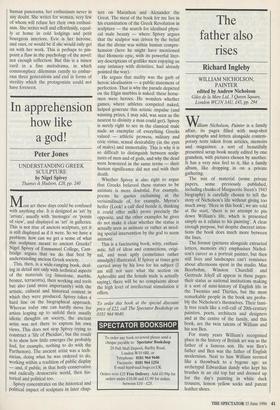In apprehension how like a god!
Peter Jones
UNDERSTANDING GREEK SCULPTURE by Nigel Spivey Thames & Hudson, £28, pp. 240 Most art these days could be confused with anything else. It is designed as 'art' by `artists', usually with 'messages' or 'points of view', and displayed as 'art' in galleries. This is not true of ancient sculpture, yet it is still displayed as if it were. So we have a problem: how can we get a sense of what this sculpture meant to ancient Greeks? Nigel Spivey of Emmanuel College, Cam- bridge argues that we do that best by understanding ancient Greek society. This, then, is a wide-ranging book, deal- ing in detail not only with technical aspects of the materials (eg limestone, marble, bronze, terracotta), their working and tools but also (and more importantly) with the artistic, cultural and historical context in which they were produced. Spivey takes a hard line on the biographical approach. Whereas today one can hardly move for artists leaping up to unfold their usually idiotic thoughts on society, the ancient artist was not there to express his own views. This does not stop Spivey trying to construct a 'life of Pheidias', but the result is to show how little emerges (he probably had, for example, nothing to do with the Parthenon). The ancient artist was a tech- nician, doing what he was ordered to do, working within a tradition of public display — and, if public, in that hotly conservative and radically democratic world, then his- torical and political too. Spivey concentrates on the historical and political impact of sculpture in later chap- ters on Marathon and Alexander the Great. The meat of the book for me lies in his examination of the Greek Revolution in sculpture — the search for idealised physi- cal male beauty — where Spivey argues that the sculptor was driven by the belief that the divine was within human compre- hension (here he might have mentioned that Homeric epic, with its powerful liter- ary descriptions of godlike men enjoying an easy intimacy with divinities, had already pointed the way).
He argues that nudity was the garb of heroic idealisation — a public statement of perfection. That is why the parade depicted on the Elgin marbles is naked: these horse- men were heroes. He wonders whether games, where athletes competed naked, helped generate this artistic impulse (and winning prizes, I may add, was seen as the nearest to divinity a man could get). Spivey is surely right to see in the classical male nude an exemplar of everything Greeks valued — athletic prowess, military and civic virtue, sexual desirability (in the eyes of males) and immortality. This is why it is so difficult to distinguish between sculp- tures of men and of gods, and why the dead were honoured in the same terms — their human significance did not end with their death.
Whether Spivey is also right to argue that Greeks believed these statues to be animate is more doubtful. For example, poems he quotes exclaiming at the verisimilitude of, for example, Myron's heifer (Look! a calf died beside it, thinking it could offer milk) prove precisely the opposite, and the other examples he gives do not make it clear whether the statue is actually seen as animate or rather as need- ing special intervention by the god to seem animate.
This is a fascinating book, witty, enthusi- astic, full of ideas and connections, origi- nal, and most aptly (sometimes rather smudgily) illustrated. If Spivey at times gets carried away by his love for his subject (I am still not sure what the section on Aphrodite and the female nude is actually saying), there will be no complaints about the high level of intellectual stimulation it offers.


































































 Previous page
Previous page